Choices, Choices – Which is Best for Me?
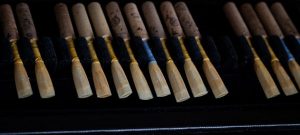 My reeds are scraped, fundamentally, according to the Philadelphia style of reed making. They would possibly alarm a purist. I’m going to use subjective descriptors to describe my reeds. The tone has a dark quality in the center with a furry wrap around the edges. It brightens as it moves upward into the higher register, but it is not shrill. The lower register is bold and can even be made pungent in quality if pushed vigorously. Some people don’t like the heavy center in the sound. If so, you can remove it by thinning the blend and “sweet spots” in the tip ever so slightly. If you prefer that, I will leave those kinds of adjustments to you. My goal is to make a very consistent reed; so, I won’t monkey with the style of my reeds, because any reed I scrape may go into your reed case or it may stay in mine.
My reeds are scraped, fundamentally, according to the Philadelphia style of reed making. They would possibly alarm a purist. I’m going to use subjective descriptors to describe my reeds. The tone has a dark quality in the center with a furry wrap around the edges. It brightens as it moves upward into the higher register, but it is not shrill. The lower register is bold and can even be made pungent in quality if pushed vigorously. Some people don’t like the heavy center in the sound. If so, you can remove it by thinning the blend and “sweet spots” in the tip ever so slightly. If you prefer that, I will leave those kinds of adjustments to you. My goal is to make a very consistent reed; so, I won’t monkey with the style of my reeds, because any reed I scrape may go into your reed case or it may stay in mine.
In general, I personally like a smaller tip opening, because I’m not in the best of shape as a player. I teach more than I perform. A smaller tip opening may not work for you. The tip opening is heavily influenced by the diameter of the tube cane and the tie dimensions. I like to make my reeds from a 10.75mm tube, and I tend to tie a bit shorter and clip at 69mm to 69.5mm, because I make a lot of student reeds for flat stuffy horns. I will adjust these criteria a bit for an adult with a good horn. Work with me to get it right for you.
The “Professional” Oboe Reed
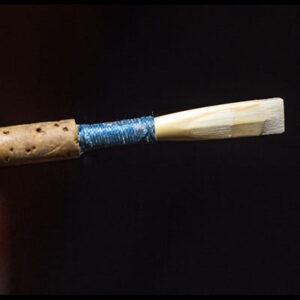 This reed is built on a 47 or 46mm large-bore tube, with a somewhat longer American scrape, scraped over several days to settle it down and allow it time to stabilize. Even so, the reed may arrive on your doorstep a little bit stiff from shipment and newness, especially if you’ve requested a bigger tip opening than I usually finish with, but it will crow at or near octave C’s, play accurate half steps at E-F and B-C with reasonable tone, play a scale at A=440 without excessive embouchure manipulation. When I finish it, will begin attacks fairly softly and taper off, and it will hold pitch in the crescendo-diminuendo. The sound quality will be “pleasant.” Some feathery adjustments to the sides of the tip and blend will get you a creamier, more focused tone with a lighter response.
This reed is built on a 47 or 46mm large-bore tube, with a somewhat longer American scrape, scraped over several days to settle it down and allow it time to stabilize. Even so, the reed may arrive on your doorstep a little bit stiff from shipment and newness, especially if you’ve requested a bigger tip opening than I usually finish with, but it will crow at or near octave C’s, play accurate half steps at E-F and B-C with reasonable tone, play a scale at A=440 without excessive embouchure manipulation. When I finish it, will begin attacks fairly softly and taper off, and it will hold pitch in the crescendo-diminuendo. The sound quality will be “pleasant.” Some feathery adjustments to the sides of the tip and blend will get you a creamier, more focused tone with a lighter response.
I will need your feedback to fine tune the reed to you and your horn. I want you to enjoy playing this reed. However, the more I finish a reed, the more my playing influences yours. It’s always possible for me to stop a day early and let you take over those last 10 minutes of adjustments. Talk to me. I will work with you.
The “Professional” English horn Reed:
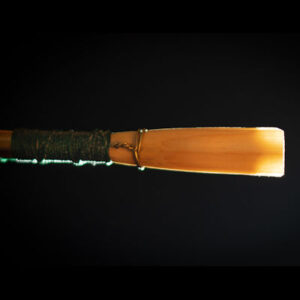 This reed is built on a Glotin or equivalent brass tube. It is also available on a Chudnow bronze tube as an upgrade. I have an assortment of brands. This reed is a Philadelphia-influenced reed, but with more a V-shaped blend, to create more power and color in the upper register. Fopr a smaller, sweeter tone, I can modify this toward the curved heart with a more blended profile and shorter tip, which will give more subtle resistance and a more vocalic sweetness for small chamber work. Both are nice options, according to the ensemble and composer you are performing. To finish this reed, the sides of the blend should be worked down on the sides into the tip, and the tip thinned in the final millimeter of tip, and be clipped perhaps a millimeter shorter than in the photo. It will have the brass wire for support, unless you prefer it left off. I place airline tubing on the tube to improve the air seal.
This reed is built on a Glotin or equivalent brass tube. It is also available on a Chudnow bronze tube as an upgrade. I have an assortment of brands. This reed is a Philadelphia-influenced reed, but with more a V-shaped blend, to create more power and color in the upper register. Fopr a smaller, sweeter tone, I can modify this toward the curved heart with a more blended profile and shorter tip, which will give more subtle resistance and a more vocalic sweetness for small chamber work. Both are nice options, according to the ensemble and composer you are performing. To finish this reed, the sides of the blend should be worked down on the sides into the tip, and the tip thinned in the final millimeter of tip, and be clipped perhaps a millimeter shorter than in the photo. It will have the brass wire for support, unless you prefer it left off. I place airline tubing on the tube to improve the air seal.
The “Studio” Oboe Reed
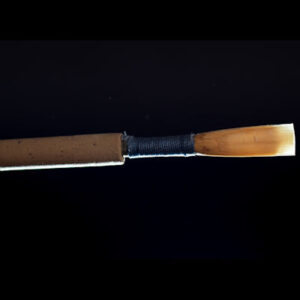 This reed will absolutely require adjustments with your reed knife. You may consider it a “hard” reed. This means it will be a little too thick in the tip and blend for optimal response, comfort, and tone color. The tip will be left long to allow for further blending and clipping. It will be high and tight in pitch center and tone quality. Expect to make adjustments to all the regions, even the plateau, to create greater responsiveness, focus, and tonal depth over the first day or two of its playing life. There will be enough tip for clipping to maintain good overall pitch.
This reed will absolutely require adjustments with your reed knife. You may consider it a “hard” reed. This means it will be a little too thick in the tip and blend for optimal response, comfort, and tone color. The tip will be left long to allow for further blending and clipping. It will be high and tight in pitch center and tone quality. Expect to make adjustments to all the regions, even the plateau, to create greater responsiveness, focus, and tonal depth over the first day or two of its playing life. There will be enough tip for clipping to maintain good overall pitch.
It will be built on a midsized brass tube with a synthetic cork, probably the Forrest 47mm brass tube with synthetic cork, or the brass Glotin with natural cork if you choose to upgrade the tube. The reed will be profiled and proportioned to clip, and it will finish at about 69-70mm, and the blend and tip will be well formed. It will be tested for an airtight seal, will crow at or close to octave C’s or C-sharps, and will be stable at the natural half steps and the crescendo-diminuendo. The reed will then be allowed to dry overnight and one more adjustment made to ensure that the tip opening is manageable and the reed is still stable at the natural half tones, and it will respond reasonably well at moderate to loud dynamic levels.
This reed is the perfect chance for you to learn to strut your stuff, and develop your finishing skills. All the cane you need to finish the reed will be left in the well-proportioned regions; so, you can make this reed your very own.
Oboe and English Horn “Blanks”
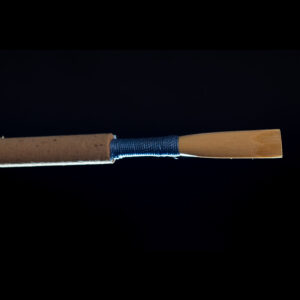
Oboe Blank
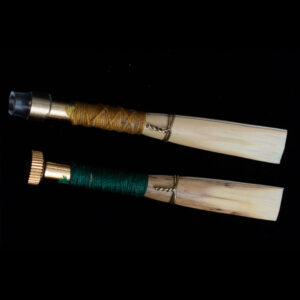
English Horn Blanks
These are reeds that don’t vibrate yet. The oboe reed in the photo to the right is Option 1 profiling. I personally prefer to go on to Option 2 and scrape the bark off just enough to form the spine and ribs down the length of the fledgling reed, and clip open the tip. The E horn reeds in the photo are Option 2. I do this because I’ve found that reed blanks that aren’t initially scraped thin enough to “set” the tip opening to finished parameters are less consistent when scraped fully. As well, they’re a lot more likely to split or flare when you create the sides of the blend and lighten the sides of the tip.
